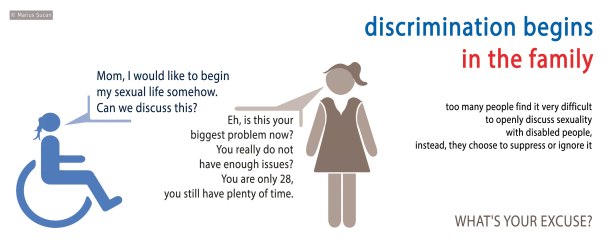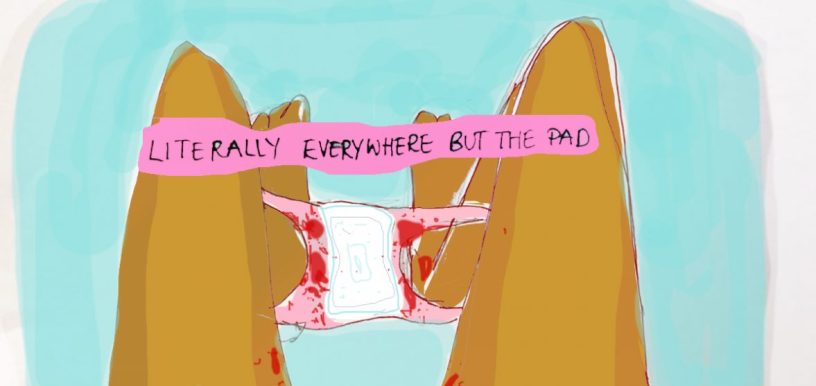
It started when I was sixteen – at night, standing in the kitchen. I don’t remember what I was doing or who else was there – I just remember the rolling, pinching pain in my lower abdomen and a stabbing pain in my lower back. The pain would stay with me for the entire week – coming and going – before the first drops of blood was – angrily? – regretfully? – squeezed out.
Before the blood, I didn’t know what was going on. At first, I thought – due to the constant diarrhea, farting, and bloating – that I ate something bad (cafeteria food). Then I thought I had a UTI – a slight discharge and always thinking I had to go pee – but eighty-percent of the time I didn’t – just sitting there, for minutes on end, listening to the running sink water, hoping that’ll get me going.
But then the blood came: droplets at first – barely noticeable, then a gush of blood, then back to barely-seen droplets. It lasted two days. The pain lasted longer.
Before I got my period, I remember wanting it so, so badly – it was a conversation I couldn’t be a part of. My friends would go on and on about pads and tampons and shots – and although none of it sounded great, I foolishly thought that to have your period is to be a woman. And I wanted so badly to be a woman – no longer a girl, finally able to be part of the world as a young woman.
But the pain – I rolled my eyes when my friends complained; I stared when my friends took pills every six hours – I was not prepared.
No. I was not prepared.
Twelve years later and I’m still not prepared. The worse part: I’m not regular. I never know when it’s coming. Last time I had it was two months ago. Sixty days.
It came a few days ago. I no longer have droplets, then a gush, then droplets again. No. Not anymore. It’s constant. A rainfall – pitter-patter against my pad, then a splat every few minutes – a large helping of blood, if you will.
The pain is not as bad as the first time. Thankfully. It still hurts – as if someone is clawing, kicking, stamping, punching my insides and drilling – yet also sitting – on my ass. I have diarrhea beforehand. I am gassy and horny. My nipples are sensitive (and not in a good way) and my breasts ache. And there is always that one craving – that one craving that I want so badly – but once I get it – after threatening and blackmailing anyone and everyone who is in my presence – I no longer want it.
Sometimes I have pain a few days before my cycle starts. Other times, I have no pain until the day of my period. And there are times – very rare – where I have no pain at all. Sometimes I know – pain or no pain – that my cycle will start soon; and others – despite the symptoms – I am one-hundred-percent sure that it is not because of my period. The mind and body are strange.
I was twenty-two when I first decided to use a tampon. Small and slim; it felt so weird going in and hurt so much coming out. I still don’t like pulling the tampon out. It took me a while to get used to it. There’s a little dance I have to do when taking it out; since I bleed heavy, I have to have a Ziploc bag in my left hand, squat over the middle of the toilet, my right hand pulls it out, and immediately goes into the bag. Avoiding blood splatters. Thankyouverymuch.
(There’s nothing like having your younger brother call you in to the bathroom and telling you that there’s blood on the toilet – and in the tub. And before you can tell him you’ll clean it up, he takes your hand and shows you how. I was so humiliatingly touched.)
If I’m doing a lot of running around for the first few days of my cycle, then I’ll use a tampon along with wearing a pad – I am really, really, heavy in the beginning. I change the tampon and pad every five hours. If it’s the weekend, or I have nothing to do, then I’ll wear a pad and change it every three hours.
Overall, I had a good experience when it comes to my period. My family was supportive, my mom was there every step of the way and answered all my questions. She showed me how to put my pad on, the different types of pads out there, and when and why you wear certain pads. My friends talked me into wearing a tampon, (peer pressure).

Being disabled and a woman – these two identities don’t always intersect; many think that the sex of a disabled person doesn’t matter – it is not as important – it does not take preference over being disabled. For many disabled women, being a woman, having the body of a woman, does not get the attention that it deserves.
A lot of disabled women – women who are disabled – are not told about their body and the changes that they will go through. Puberty. How will a disabled girl be able to keep up with all the changes? Will they be able to mentally understand what is going on?
I was in the fifth grade when the boys and girls were split up – the boys went to the gym and the girls went to the library. We watched a ten-minute cartoon video that went over our bodies (vagina, breasts, ovaries and uterus), pregnancy, didn’t mention sex, and did not go into consent. We did not have someone talk to us – it was just a group of girls on the floor of the library watching a ten-minute video of a silent cartoon woman and the voice of a man occasionally chiming in with key words. There was no discussion afterward. We all got up and went back to class. I didn’t have a clue what was going on in the video. A silent woman and every now and again, a man would say “egg,” “ovary,” “uterus.” Yelling words at me didn’t do me any good.
I learned about puberty, sex, and STD’s later. Talking with my mom, giggling and wondering with my friends, and researching everything else on my own.
I was one of the lucky ones: many who are disabled didn’t have the talk with a family member – some were told by doctors or felt that it would be useless because they wouldn’t understand or wouldn’t need the information; or when it came time to sex education at school, the teacher made the decision to exclude them – thought it would be better for them to go to lunch early, go study, hang out for a few minutes. Many disabled adolescences are turned away if they ask questions on puberty or sexuality. This is not unusual. To society, the thought of people who are disabled and their sexual organs – working sexual organs – doesn’t seem to go together.

The result: ignorance leads to unpreparedness which leads to negative consequences. If someone doesn’t know basic human reproduction – what is a sexual organ, what is the use of it, how to keep it clean, where does a baby come from, how is a baby made – then – at best – the young woman is pregnant or has an STD, or – at worse – the young woman is raped.
Many times, the family decides or takes advice from the doctor instead of asking the young woman for her thoughts; menstruation suppression, hormone therapy, birth control, or sterilization. Before the young woman even knows what is going on, her choice is taken away. She is not even given a chance to prove herself or to get used to her body.
The United States has always had a problem when it comes to sexual education – in school or at home. Comprehensive sex education or abstinence only. Knowledge or ignorance. Acknowledged or avoidance. Good or bad. Healthy or unhealthy. Who deserves it, who doesn’t. The right way and the wrong way to have and think about sex. Immoral and moral. When, where, and how to have sex.
The way we talk about, teach, and present sexual education isn’t working. But also: the audience we choose is wrong too. Students are missing in that classroom. Those who are there aren’t getting the full effect because it is not accessible. Those who try to learn more are turned away because someone has made the decision that the young adult doesn’t need to know.
We need to change the conversation, yes. But we need to change the audience too.
Puberty hits everyone – not all at the same time and not the same way – but it comes. We all deserve to meet it with knowledge and understanding. We have that right.
